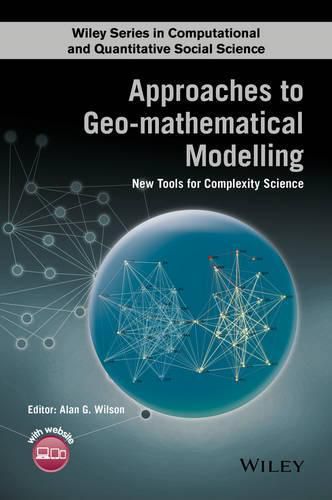Readings Newsletter
Become a Readings Member to make your shopping experience even easier.
Sign in or sign up for free!
You’re not far away from qualifying for FREE standard shipping within Australia
You’ve qualified for FREE standard shipping within Australia
The cart is loading…






Geo-mathematical modelling: models from complexity science
Sir Alan Wilson, Centre for Advanced Spatial Analysis, University College London
Mathematical and computer models for a complexity science tool kit
Geographical systems are characterised by locations, activities at locations, interactions between them and the infrastructures that carry these activities and flows. They can be described at a great variety of scales, from individuals and organisations to countries. Our understanding, often partial, of these entities, and in many cases this understanding is represented in theories and associated mathematical models.
In this book, the main examples are models that represent elements of the global system covering such topics as trade, migration, security and development aid together with examples at finer scales. This provides an effective toolkit that can not only be applied to global systems, but more widely in the modelling of complex systems. All complex systems involve nonlinearities involving path dependence and the possibility of phase changes and this makes the mathematical aspects particularly interesting. It is through these mechanisms that new structures can be seen to ‘emerge’, and hence the current notion of ‘emergent behaviour’. The range of models demonstrated include account-based models and biproportional fitting, structural dynamics, space-time statistical analysis, real-time response models, Lotka-Volterra models representing ‘war’, agent-based models, epidemiology and reaction-diffusion approaches, game theory, network models and finally, integrated models.
Geo-mathematical modelling:
Presents mathematical models with spatial dimensions. Provides representations of path dependence and phase changes. Illustrates complexity science using models of trade, migration, security and development aid. Demonstrates how generic models from the complexity science tool kit can each be applied in a variety of situations
This book is for practitioners and researchers in applied mathematics, geography, economics, and interdisciplinary fields such as regional science and complexity science. It can also be used as the basis of a modelling course for postgraduate students.
$9.00 standard shipping within Australia
FREE standard shipping within Australia for orders over $100.00
Express & International shipping calculated at checkout
Stock availability can be subject to change without notice. We recommend calling the shop or contacting our online team to check availability of low stock items. Please see our Shopping Online page for more details.
Geo-mathematical modelling: models from complexity science
Sir Alan Wilson, Centre for Advanced Spatial Analysis, University College London
Mathematical and computer models for a complexity science tool kit
Geographical systems are characterised by locations, activities at locations, interactions between them and the infrastructures that carry these activities and flows. They can be described at a great variety of scales, from individuals and organisations to countries. Our understanding, often partial, of these entities, and in many cases this understanding is represented in theories and associated mathematical models.
In this book, the main examples are models that represent elements of the global system covering such topics as trade, migration, security and development aid together with examples at finer scales. This provides an effective toolkit that can not only be applied to global systems, but more widely in the modelling of complex systems. All complex systems involve nonlinearities involving path dependence and the possibility of phase changes and this makes the mathematical aspects particularly interesting. It is through these mechanisms that new structures can be seen to ‘emerge’, and hence the current notion of ‘emergent behaviour’. The range of models demonstrated include account-based models and biproportional fitting, structural dynamics, space-time statistical analysis, real-time response models, Lotka-Volterra models representing ‘war’, agent-based models, epidemiology and reaction-diffusion approaches, game theory, network models and finally, integrated models.
Geo-mathematical modelling:
Presents mathematical models with spatial dimensions. Provides representations of path dependence and phase changes. Illustrates complexity science using models of trade, migration, security and development aid. Demonstrates how generic models from the complexity science tool kit can each be applied in a variety of situations
This book is for practitioners and researchers in applied mathematics, geography, economics, and interdisciplinary fields such as regional science and complexity science. It can also be used as the basis of a modelling course for postgraduate students.